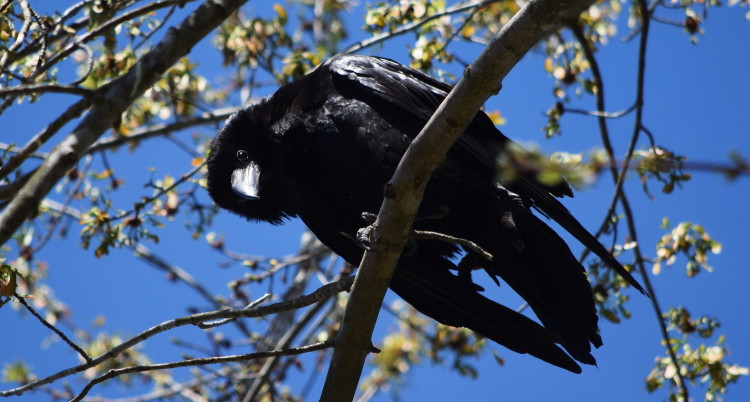A few weeks ago, DOEE Wildlife Biologist Dan Rauch discovered a nesting pair of Common Ravens in DC. This was a surprising discovery. Although other corvids, such as American Crows, Fish Crows, and Blue Jays reside in the DC area, Ravens have not been breeding in DC for over 100 years and historical records of them in our area are few and far between.
Since Ravens are not migratory birds, they usually remain in the area after establishing a new territory. This means our nesting Ravens may mark the beginning of a return of breeding Ravens to our area. They have previously been spotted near the Potomac River Gorge, Kenilworth Aquatic Gardens, and the National Arboretum.
About half again larger than American Crows, these majestic birds are smart, adaptive, and well suited to living in urbanized areas. Ravens, like crows and other corvids, have unusually good problem solving skills, memory, and can teach and learn from one another. They also have a clear understanding of cause and effect. These traits make them exceptional hunters and scavengers. They will eat just about anything and are happy to work together, especially if it means they will have a better chance of scoring a meal.

Some favorite foods include: carrion, small animals (such as: mice, baby birds, baby tortoises), medium sized animals (such as: Rock Pigeons and nestling Great Blue Herons), eggs, insects (such as: grasshoppers, beetles, scorpions, and other arthropods), fish, grains, and berries. They will also happily consume most human and pet food left unattended or thrown in the garbage.
Unlike crows, Ravens are most often seen in pairs, or alone. Pairs will stay together year round and begin breeding sometime between mid February and May. DC’s nesting Ravens are currently sitting on several eggs (between 4-7 is typical for Ravens) and Dan Rauch has been checking in on the nest once a week. One the eggs hatch and the young are old enough, they will disperse to a new area (likely still in DC or close by).
The Raven’s return is exciting from both an environmental perspective and a cultural one. Ravens have long held a prominent place in the mythology of many civilizations, with more common stories included in Greek, Roman, Celtic, Pacific Northwest, and Norse mythology. They have worn the role of clever trickster, sage, and messenger of the gods and been symbols of war, death, misfortune, and evil. When you see a raven it is hard not to think of Edgar Allen Poe’s “The Raven.” Similarly, with its long beak, jet black feathers, and imposing frame, you don’t have to try very hard to understand why the bird captured Poe’s imagination. It has certainly captured ours.
No comments:
Post a Comment